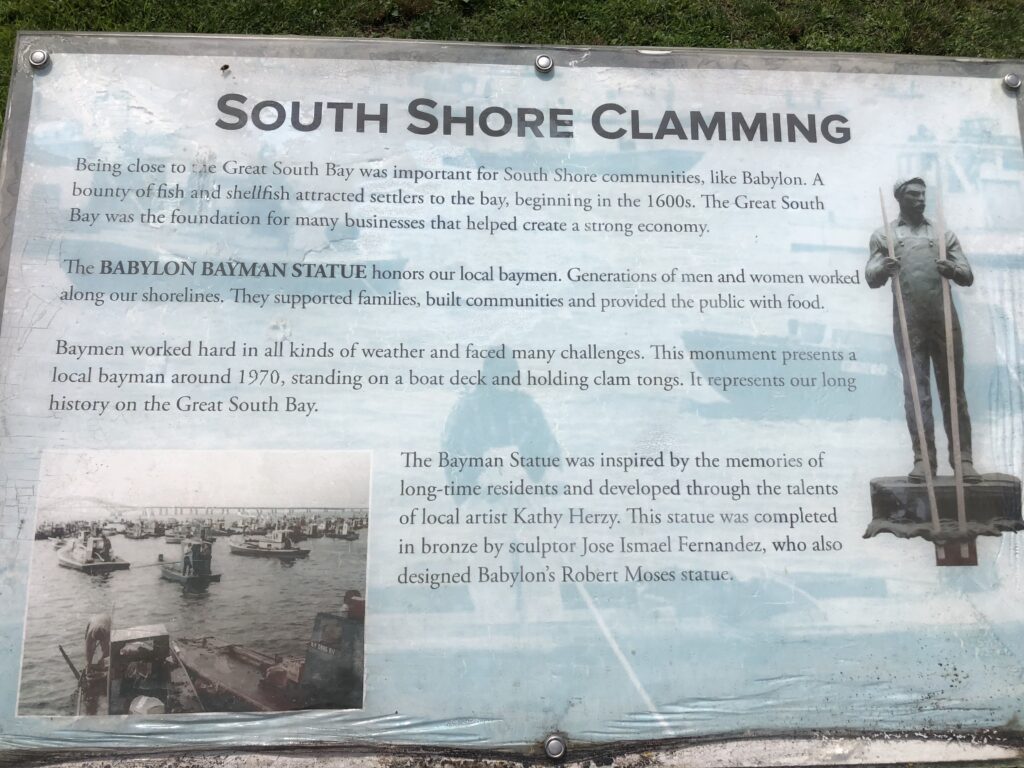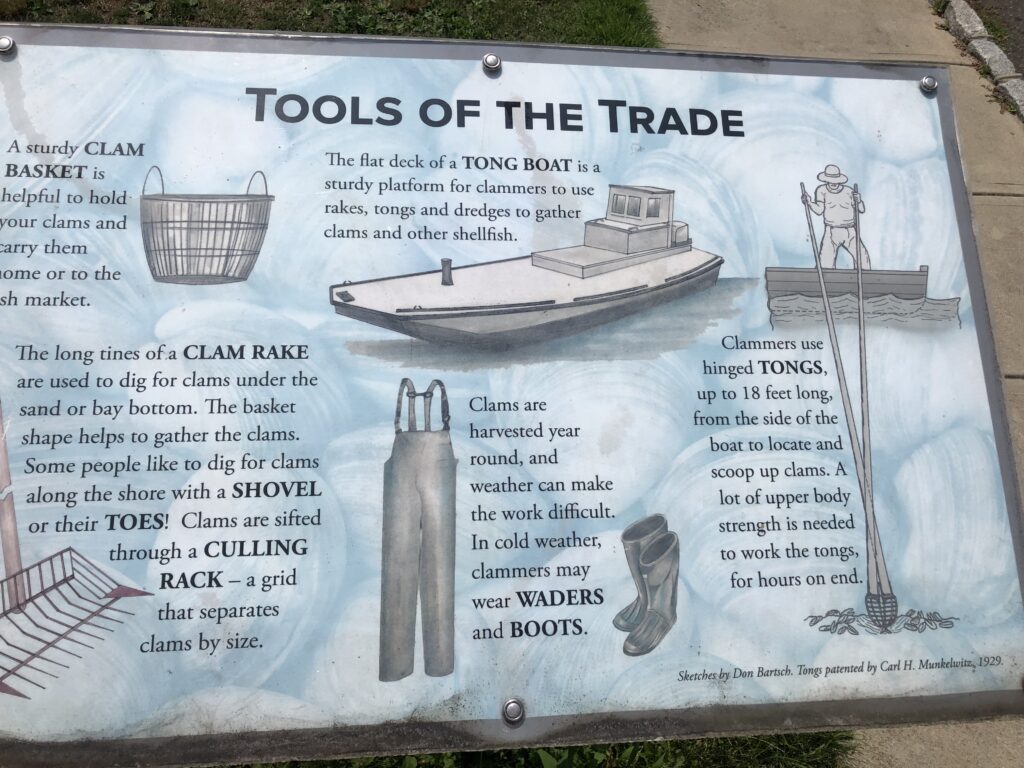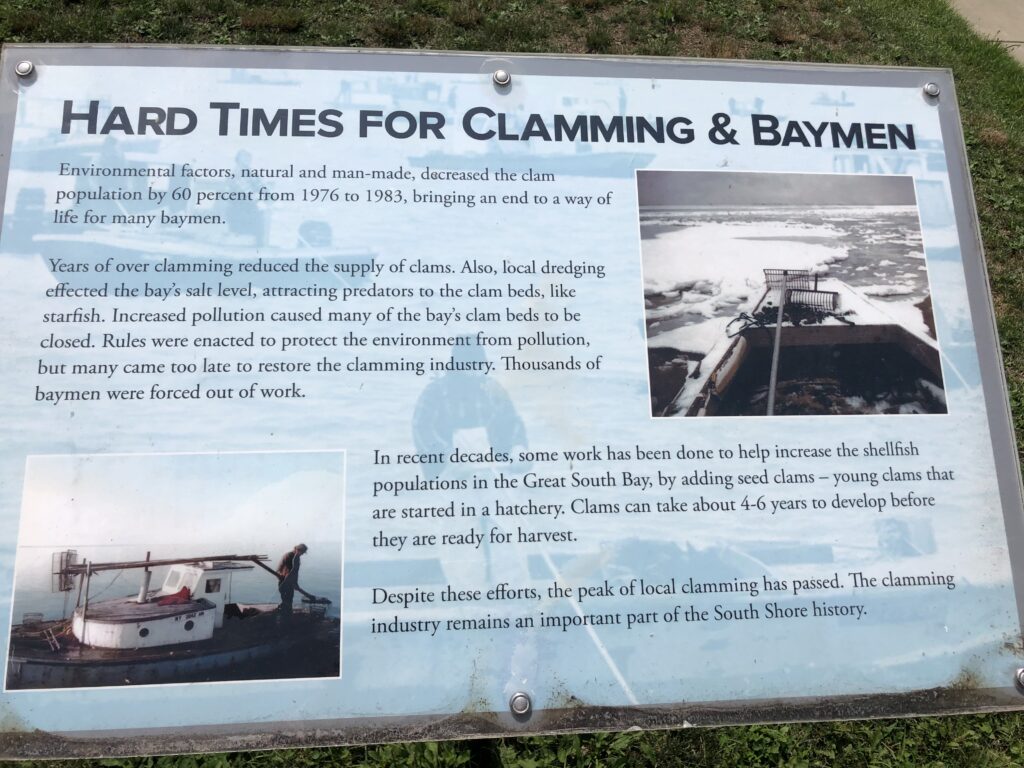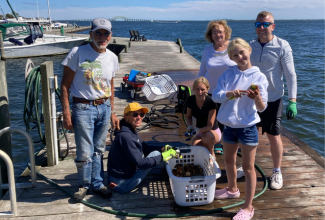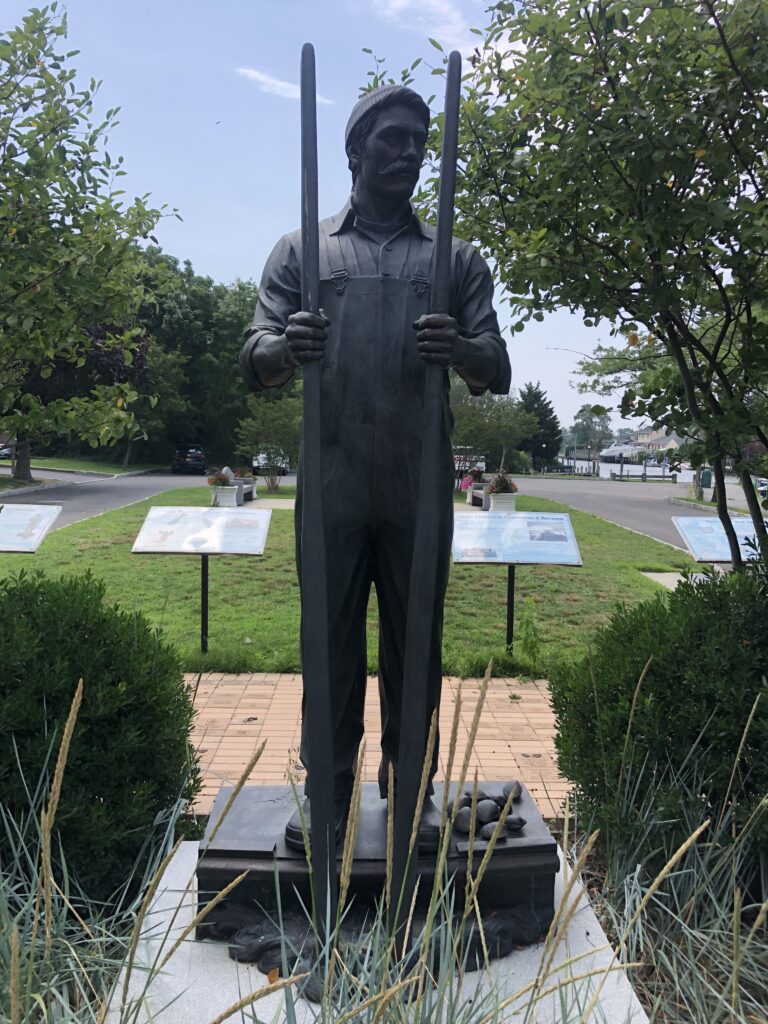31 May 2025
This summer, the South Shore of Long Island isn’t just nurturing oysters — it’s reviving a centuries-old tradition of stewardship, sustainability, and community connection.
Table of Contents
- The Bay That Built Us
- Tools of the Trade
- Collapse & Consequence
- A Comeback Story
- Get Involved
- Why This Matters
- The Bayman Statue & What It Stands For
🌊 The Bay That Built Us
Long before summer volunteers were tending baby oysters on dockside gardens, the Great South Bay was the economic lifeblood of Long Island’s South Shore. As early as the 1600s, settlers were drawn to the bay for its abundance of fish and shellfish, which helped build thriving waterfront communities like Babylon, Bay Shore, and Oakdale.
By the early 1900s, Long Island had become world-famous for its clamming industry. More than 2 million bushels of clams were harvested from the bay each year and shipped around the globe. This wasn’t just a summer job — it was a way of life.
Unlike other shellfish, clams can be gathered year-round. Baymen worked dawn to dusk, digging through icy waters in the winter and baking sun in the summer. It was physically demanding work that supported thousands of families and formed the cultural backbone of the region.
By the late 1960s, local baymen were responsible for nearly half of all clams consumed in the United States — a staggering 5.5 million pounds annually. Over 4,000 Long Islanders held clamming licenses, and while many worked part-time, others were full-time professionals who also harvested scallops, oysters, eels, and fish.
The bay wasn’t just water — it was the workplace, classroom, and heart of the community.
🛠️ Tools of the Trade
The Great South Bay’s legendary shellfishing success wasn’t possible without the right tools — and the sheer grit of the baymen who used them. While today’s volunteers may use hoses and data sheets to tend to oysters, their work echoes the hands-on tradition of clammers who once worked the bay from sunup to sundown.
Some of the traditional tools included:
- Clam Basket – A sturdy metal or wire basket used to hold and transport clams, either home or to market.
- Clam Rake – A long-handled rake with metal tines used to dig clams from the sandy bottom of the bay. The basket-like shape helped scoop and gather clams efficiently.
- Shovel (or even toes!) – Along the shoreline, people would dig with whatever they had, sometimes even their bare feet.
- Culling Rack – A sorting grid used to separate clams by size, especially for market sorting.
- Tong Boat – A flat-decked boat that allowed baymen to stand and work with tongs or dredges from above the waterline.
- Tongs – Long hinged poles, sometimes up to 18 feet long, used to locate and scoop clams from the bay floor. Operating tongs required significant upper body strength and hours of endurance.
- Waders and Boots – Essential gear for baymen working in colder months or near the shoreline.
These tools weren’t just equipment — they were extensions of the baymen themselves. Each was crafted for efficiency, durability, and survival in a world where the elements were as much a challenge as the work itself.
⚠️ Collapse & Consequence
As prosperous as the clamming industry once was, its decline was sharp and devastating. Between 1976 and 1983, environmental and man-made factors caused clam populations in the Great South Bay to plummet by over 60%. For many local baymen, this marked the end of a way of life.
The fall came from a combination of causes:
- Overharvesting depleted natural clam beds faster than they could replenish.
- Pollution from industrial runoff, sewage, and stormwater choked the bay with nitrogen and harmful algae blooms.
- Dredging and development disrupted habitats and changed the salinity of the water, making it inhospitable to shellfish.
- Predation by starfish and other opportunistic species further decimated clam beds.
Many clam beds had to be closed. Regulations were introduced to protect the ecosystem, but by the time enforcement arrived, much of the damage was already done. Thousands of full- and part-time baymen were forced out of work.
Though the clamming boats are fewer and the docks quieter, the legacy of this loss is still felt today — in local economies, family stories, and the water itself.
🌱 A Comeback Story
Though the peak of Long Island clamming has passed, hope for the Great South Bay is far from lost. Thanks to the combined efforts of environmental groups, volunteers, and science-backed restoration projects, the bay is beginning to breathe again—thanks to the miracle mollusk: the oyster.
Unlike clams, oysters offer something extraordinary: natural water filtration. A single oyster can filter up to 50 gallons of water per day, removing harmful pollutants like nitrogen, improving clarity, and restoring oxygen levels. That means healthier waters, more resilient ecosystems, and a renewed future for aquatic life.
The Community Oyster Garden Project, led by Save The Great South Bay, is placing over 150,000 baby oysters (called spat) into floating dockside cages along the South Shore this summer. Each week, volunteers clean the oyster crates, measure the spat’s growth, and track their development—all preparing them for their permanent move into the open bay in September.
This is more than an environmental project—it’s a restoration of local pride and shared responsibility. Every cleaned crate and measured oyster helps restore a vital resource that once defined this region’s identity.
From water clarity to fish habitats, the return of oysters may help bring the bay, and our coastal communities, back to life—one shell at a time.
🧑🤝🧑 Get Involved — Volunteer Opportunities
You don’t have to be a marine biologist to make a difference. The Community Oyster Garden Project is powered by everyday Long Islanders—students, parents, retirees, and local leaders—who give just an hour of their time to restore the Great South Bay.
Volunteering is easy, rewarding, and completely dockside. No diving, boats, or prior experience required. Just wear clothes you don’t mind getting a little wet or dirty!
📍 Community Oyster Garden Locations & Schedule
- Snapper Inn, Oakdale – Mondays, 10:00 AM – 12:00 PM
- Walker Beach, Brightwaters – Mondays, 12:30 PM – 2:30 PM
- Babylon Yacht Club – Mondays, 3:00 PM – 5:00 PM
- Bay Shore Yacht Club – Wednesdays, 10:00 AM – 12:00 PM
The program runs from June 30 to September 15, and volunteers can participate once, weekly, or as often as they’d like.
🧤 What You’ll Do:
- Lift and hose off oyster crates
- Count and measure baby oysters (spat)
- Record data to help track growth and health
- Learn about shellfish restoration and water quality
All equipment is provided—just bring your curiosity and a love for your local waters.
📲 Click here to sign up to volunteer or scan the QR code on the flyer. You’ll receive instructions and reminders by email—and every visit helps restore the bay.
💬 Why This Matters
The Community Oyster Garden Project isn’t just about cleaning water—it’s about reviving a way of life. This work benefits more than the bay. It strengthens our community, supports local business, and offers families a hands-on, feel-good way to reconnect with Long Island’s roots.
🏘️ For the Community
- Rebuilds civic pride by engaging residents in the care of their natural surroundings
- Restores a shared heritage—the bay was once the center of life for many South Shore families
- Brings neighbors together to work toward a common, visible goal
💵 For Local Commerce
- Improved water quality helps boost recreational boating, kayaking, fishing, and swimming
- Healthier waters mean long-term gains for seafood, tourism, and waterfront dining industries
- Businesses that sponsor or support restoration efforts benefit from positive public visibility and community goodwill
👨👩👧 For Families
- Free, educational fun for kids and adults alike—no screens required!
- Perfect for students seeking community service hours
- Hands-on learning about ecology, marine biology, and sustainability
- A way to build memories while giving back to the place we call home
[Insert Image: Smiling family or students measuring oysters or cleaning crates together]
Whether you volunteer one time or every week, your contribution ripples out across the water—and across generations.
🗿 The Bayman Statue & What It Stands For
Standing proudly along the Babylon Village docks is a silent sentry—a statue of a lone bayman holding his clam rake and basket. Sculpted with care and purpose, the Babylon Bayman Statue honors the thousands of hardworking men and women who once earned their living from the Great South Bay.
Commissioned by the Village of Babylon and created by artist
Its placement near the marina serves as a daily reminder: the health of the bay is linked to the health of our communities. Preserving our waters is not only an environmental cause, but also a cultural responsibility.
Today’s oyster volunteers are walking in those same weather-worn footsteps. They may use different tools and wear modern clothes, but their mission is similar—to work with the bay, not against it. To restore, protect, and honor what has come before.
The bayman statue stands still, but the movement it represents is alive—and growing stronger with every crate cleaned and oyster planted.
✅ Ready to Help the Bay Breathe Again?
The bay gave so much to generations before us—food, jobs, family memories, and an identity. Now, we have the chance to give something back. Whether you’re a student looking for service hours, a family seeking a meaningful summer activity, or a local business hoping to support sustainability, the Community Oyster Garden Project is your invitation to take part in something lasting.
🌊 One hour of your time can filter thousands of gallons of water. That’s impact.
📲 Click here to sign up and volunteer now
or scan the QR code on the flyer. You’ll receive a reminder and all the information you need to show up and make a difference.
📢 Spread the Word
If you can’t join, you can still help by sharing this post and tagging friends and family who might love the experience.
Use these hashtags to share your oyster garden story:
#SaveTheGreatSouthBay #LongIslandOysters #CommunityOysterGarden #BaymenStrong #ILoveBabylon #FamilyVolunteering #OysterRestoration
Together, we can turn back the tide—and make the bay a source of life, learning, and pride once more.
